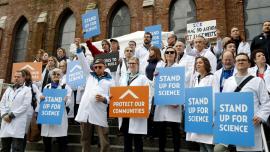
Tens of thousands, many of them scientists, joined the March for Science on Earth Day, April 22, in cities across the United States and around the world. There were some 400 marches in the US with crowds estimated at 20,000 in New York and Los Angeles, some 15,000 gathered on the Washington Mall, and 1,000 in Portland, Oregon. Other marches took place in hundreds of other cities around the world from London to Tokyo.
 The march was largely motivated by President Donald Trump’s proposed budget that would cut funding for many science programs, including the Environmental Protection Agency (EPA), which is being cut by 31 percent. Marchers in Washington carried signs reading, “Save the EPA.” and “Save the NIH” The NIH is the National Institutes of Health, which is also being cut by 18.3% or $5.8 billion. Other marchers in various cities carried signs reading, "There Is No Planet B," and "Make Science Great Again" among many others.
The march was largely motivated by President Donald Trump’s proposed budget that would cut funding for many science programs, including the Environmental Protection Agency (EPA), which is being cut by 31 percent. Marchers in Washington carried signs reading, “Save the EPA.” and “Save the NIH” The NIH is the National Institutes of Health, which is also being cut by 18.3% or $5.8 billion. Other marchers in various cities carried signs reading, "There Is No Planet B," and "Make Science Great Again" among many others.
Many marched for fact-based or evidence-based discussion and debate in society around questions such as global warming, as opposed to the explosion of fake news. Marching in San Diego, Solange Jacobs Randolph expressed he views of many across he country. “We can't have policy that's not based on facts. And we've got too much of that going on in America today, where our President, at the highest level, is not leading with fact-based evidence,” she said.
In San Francisco one sign read, “Make America Smart Again!” Some marchers there modifying a classic chant shouted, “What do we want? Evidence-based science! When do we want it? After peer review!” Concern about climate change was high on the list of the marchers’ concerns, as were other environmental issues. Some marchers in Los Angeles carried signs that simply read: “Water.”
The march was sponsored by a variety of scientific organizations, among them the American Association for the Advancement of Science, the American Geophysical Union, the American Chemical Society, and he Paleontology Society. Public health physicians, nurses, and other health workers participated in significant numbers. Many of the scientists marched with their families in spring rains on the East Coast.
Originally organized through the social media site Reddit and then through a Facebook event site, within a week the supporters grew from 200 to 300,000. Popular educator Bill Nye “the science guy,” Mona Hanna-Attisha, pediatrician and the key whistleblower in the Flint Water Crisis, and Lydia Villa-Komaroff, a cellular biologist and among the first Mexican-American women in the United Sates to receive a doctorate in the sciences served as the public faces of the March.
While not so central to the leadership of the March for Science as they have been in other protests, in several cities Democratic Party politicians spoke at the rallies. In Los Angeles, Democratic Congressman Brad Sherman told marchers there, “Not since Galileo was condemned by the Inquisition have science-deniers had such powerful friends.”
In San Francisco, however, no politicians were permitted to speak. “Science is nonpartisan. That’s the reason that we respect it, because it aims to reduce bias. That’s why we have the scientific method. We felt very strongly that having politicians involved would skew that in some way,” Caroline Weinberg, a public health researcher and co-organizer of the march, said at the National Press Club earlier this month.


Sacramento Science March
I estimate the Sacramento Science March participation at 12 to 15 thousand, based on partial count observation and a review of my photos currently undergoing first edit. That many people all on the same page at the same time was not only awe-inspiring, it was moving. Now to keep the political part moving.